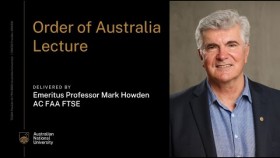Why we’re in a water emergency and what we can do about it
In October 2019, leading ANU water economist, Prof Quentin Grafton, called on the government to declare a water emergency to focus attention on Australia’s dire water situation. Prof Grafton’s research highlights that this is not just a natural phenomenon. It’s also a manmade crisis, caused by failure to heed research on our changing climate and to effectively manage our water resources.
“Simply saying that it’s a drought, so we can’t do anything about it apart from drought relief, is absolute nonsense’,” says Prof Grafton. “Whilst Australia has a history of droughts, climate modelling has warned us that evaporation will be higher as temperatures rise, yet we’ve taken management decisions that have made the situation worse. There are a range of solutions but they’re just not being taken up.”
Prof Grafton, who’s based at the Crawford School of Public Policy, has been researching water management since the early 2000s. He was drawn to the subject during the Millennium Drought because water and the lack of it is so fundamental to Australia.
Now Australia’s water situation has been thrown into stark relief again by the drought in Eastern Australia, which started in 2017. The situation in the Murray Darling Basin (MDB) is particularly dire, with rivers drying up, the Menindee Lake fish kills in Jan 2019 and some towns running out of water completely.
According to Prof Grafton, the situation in the MDB is not unexpected, with research from the 1990s onwards forecasting that climate change would change precipitation and evaporation patterns. In early 2019, three new reports were released. These reports, by the Productivity Commission, the South Australian MDB Royal Commission and the Australian Academy of Science (with contributions from ANU researchers, Prof Craig Moritz and Emeritus Prof John Williams), revealed that management of the MDB had not considered the published science on projected temperature rise.
Research by Prof Grafton and Prof Jamie Pittock (ANU Fenner School) highlights that the establishment of the MDB Plan had relied on past temperature records (from 1895-2009) and didn’t consider CSIRO research that evaluated sustainable water yields and forecast reduced precipitation in the Southern part of the MDB from 2020 and beyond.
“Trends in temperature rise are happening even faster than we’d thought – and that has major impacts for water in the context of higher rates of evaporation” said Prof Grafton.
Prof Grafton’s research also shows that it’s not just climatic conditions and the lack of rainfall that have caused these problems. The levels of extraction are very high in MDB – in some areas, 70% of stream flows are being taken out of the system. As a result, many communities don’t have access to drinking water or water to bathe because of poor water quality.
“We clearly have a major problem – I’m calling it an emergency because it’s across a wide area, it’s across all sorts of dimensions, the environment, culture, communities, farming, and that requires action” said Prof Grafton. “It requires due consideration of a series of different options, which will vary depending on where you are.”
Prof Grafton is keen to open up the options for responding by putting a range of management strategies on the table. He suggests that one of the first actions would be to do a water audit so that we understand where water is being stored, what it’s used for, the implications of extractions and how much goes back into streams. Remote sensing means that this would not be difficult or expensive. Other solutions include managed aquifer recharge, water recycling and, in a few cases, building larger dams, although this is ineffective in areas where rainfall is less than 600mm per annum.
He also recommends taking an adaptive management approach as the situation changes, rather than sticking with a plan that was written before the current drought kicked in.
“My argument is not to scrap the plan, it’s to adapt it to the situation as it changes. We have a water emergency right here, right now - we can’t just wait for a new plan in 2026,” he said.
A recent paper by Prof Grafton and Prof Williams , ‘Rent-seeking behaviour and regulatory capture in the Murray-Darling Basin, Australia’, is published in the International Journal of Water Resources Development.










